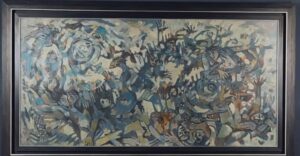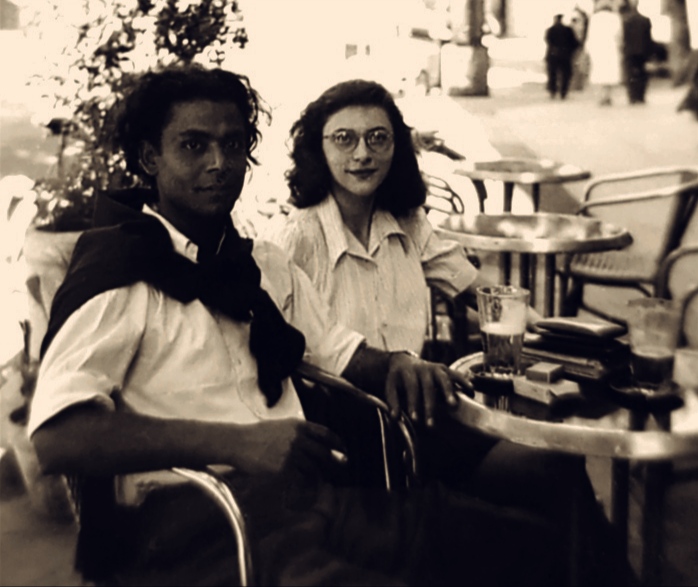Story by Manashimaya

Nearly forgotten today, Nirode Mazumdar once dominated the art scene from the 1940s onward, casting a towering presence akin to a colossus. Well ahead of his time, Mazumdar embraced symbolism before it gained widespread recognition among his contemporaries, employing it extensively to convey his philosophical and artistic ideals. His artworks, rooted in the concept of “constructive symbolism,” carried profound layers of meaning and served as a testament to his visionary approach. Regarded as a significant artist of the 20th century, Mazumdar attained a near-cult status within the art community and stood as a formidable figure of modernism.
Under the guidance of Kshitindranath Majumdar, a pupil of Abanindranath Tagore, Nirode Mazumdar received his initial artistic training at the Indian Society of Oriental Art in Calcutta. During this time, he had the opportunity to interact closely with Abanindranath Tagore himself. Upon completing his studies, Mazumdar was honored with the Norman Blount Memorial Award for his exceptional artistic talent.
Mazumdar’s career unfolded against a rapidly changing artistic landscape in post-independence India. During this time, a group of progressive artists in Kolkata, known as The Calcutta Group, emerged as pioneers of modern Indian art. Mazumdar, deeply influenced by the ethos of The Calcutta Group, embraced their spirit of experimentation and innovation, forging his path within the realm of contemporary art.

Photo courtesy DAG
Mazumdar actively participated in national and international exhibitions during his career, presenting his colorful and provocative artworks to a wide range of viewers. He became well-known in modern Indian art because of his captivating compositions, audacious use of color, and inventive techniques.
Mazumdar drew inspiration for his paintings from sources, traditional Indian art traditions, surrealism, and cubism. His distinctive style was a synthesis of Eastern and Western elements. Through abstract forms and symbolic imagery, his paintings frequently addressed topics of nature, spirituality, and the human condition, encouraging viewers to reflect on the mysteries of existence.
One of Mazumdar’s most well-known compositions is “Eternal Moments,” a mesmerizing piece that perfectly expresses transcendence and timelessness. Mazumdar uses dynamic brushwork and vivid colors to create a sense of movement and energy in this piece of art, enticing viewers to reflect and learn about themselves.
Mazumdar’s “Celestial Rhythms,” a captivating investigation of the interconnectivity of the cosmos, is another noteworthy work. Mazumdar’s use of geometric shapes and heavenly motifs in this artwork reflects his profound respect for the cosmic order and the secrets of the cosmos evoking a sense of harmony and togetherness within the universe.

Mazumdar’s artwork continues to impact future generations of artists and art Aficionados, solidifying his status as a visionary artist. His vivid and thought-provoking compositions continue to excite audiences worldwide, promoting a wider understanding of the depth and diversity of Modern Indian art. His significant impact on the art world is timeless.
In conclusion, Nirode Mazumdar’s early life, career, involvement with The Calcutta Group, distinctive style, and enduring legacy collectively illuminate his significant contributions to Indian contemporary art. Mazumdar created new avenues for artistic expression through his inventive methods, leaving a creative, inspirational, and culturally enriching legacy that captivates audiences worldwide.

Abstract Expressionism: Nirode Majumdar, a formidable figure of modernism.
Location
2020 Lomita Blvd,
Torrance, CA 90101
United States
Pages
Proudly powered by WordPress

Fantastic
Apart from his work I always remember
Meeting of family history wife Nirodda,Aditi,Chtrovanu in front of Flurys,park street.it was there meeting point in mid 70s.
Thank you!
When I was too young I heard about legend artist Nirod Mazumdar and when I entered at art college I saw very few painting exhibition of his and was overwhelmed of his mesmerizing colour distributions. I found there was a musical rhythm in his paintings. The book which he wrote ‘Punoscho Paris’ simply to say it’s wonderful.
Thank you.